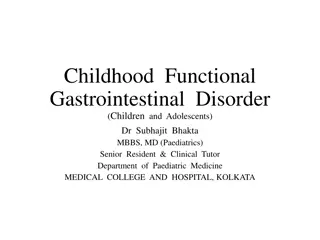
DMARDs and Biologic Disease Modifiers in Rheumatic Disorders
This information covers the features, clinical uses, mechanisms of action, pharmacokinetics, adverse effects, and specific drugs like hydroxychloroquine, methotrexate, and biologic disease modifiers in managing rheumatic disorders. Learn about the benefits, side effects, and utilization of these medications.
Download Presentation

Please find below an Image/Link to download the presentation.
The content on the website is provided AS IS for your information and personal use only. It may not be sold, licensed, or shared on other websites without obtaining consent from the author. If you encounter any issues during the download, it is possible that the publisher has removed the file from their server.
You are allowed to download the files provided on this website for personal or commercial use, subject to the condition that they are used lawfully. All files are the property of their respective owners.
The content on the website is provided AS IS for your information and personal use only. It may not be sold, licensed, or shared on other websites without obtaining consent from the author.
E N D
Presentation Transcript
BY PROF. DR. AZZA EL-MEDANY OSAMA YOUSIF
General Features & Conditions to use DMARD Low doses are commonly used early in the course of the disease Used when the disease is progressing & causing deformities or damage Used when the inflammatory disease is not responding to NSAIDs Can not repairthe existing damage , but prevent further deformity Have no analgesic effects Slow onset their effects take from 6 weeks up to 6 months to be evident
General Clinical Uses Treatment of rheumatic disorders Combination therapies are both safe & effective
Hydroxychloroquine Mechanism of action : Trapping free radicals Suppression of T lymphocyte cells
Pharmacokinetics Rapidly & completely absorbed following oral administration. Penetrates into C.N.S. & Cross the placental barrier Metabolized in liver
Adverse Effects Pruritus Headaches GIT upset Blurred vision Discoloration of nail beds & mucous membranes Irreversible retinal damage
Methotrexate Immunosuppressant drug Used mainly as chemotherapy for cancer treatment Doses of methotrexate as antirheumatic are much lower than those needed in cancer chemotherapy Given once a week
Mechanism of action Inhibition of T-Cells ( cell-mediated immune reactions)
Nausea Cytopenia Adverse Effects Liver cirrhosis Acute pneumonia Mucosal ulceration
Biologic disease modifiers Genetically engineered drugs that are used to modify imbalances of the immune system in autoimmune diseases. (1)Block, or modify the activity of selected cells in the immune system. (2)Blocking action of certain mediators that responsible for inflammatory conditions.
Classification of biologic disease modifiers T-cell modulating drug ( abatacept ) B-cell cytotoxic agent ( rituximab ) Anti-IL-6 blocking agents (Tocilizumab) TNF- blocking agents ( infliximab)
Tocilizumab IL-6 receptor inhibitor Blocks the activity of IL-6 mediated signaling Half-life is dose dependent (11-13 days ) Given as monthly IV infusion Used as monotherapy in adult with rheumatoid arthritis or in children over 2 years with systemic juvenile arthritis
Cont. In combination with methotrexate or other non biologic anti-rheumatic drugs in patients with active rheumatoid arthritis
Side effects Severe infusion reactions Serious infections ( bacterial, tuberculosis ,fungal Increase cholesterol level Increase liver enzymes Decrease in WBCs Blood tests will be used monthly for increase in cholesterol, liver enzymes & decrease in WBCs
Tumor necrosis factor (TNF- ) blocking agents
Infliximab A chimeric antibody ( 25% mouse, 75% human)
Mechanism of action Binds to human TNF- resulting in inhibition of macrophage & T cell function
Infliximab Given as IV infusion over at least two hours Half-Life 8-12 days Given every 8 weeks regimen. Elicits up to 62% incidence of human antichimeric antibodies. Concurrent therapy with methotrexate decreases the incidence of human antichimeric antibodies Contraindicated in patients with a history of tuberculosis
Upper respiratory tract infections Pancytopenia Adverse effects Activation of latent tuberculosis Infections Infusion reactions
Comparison between NSAIDs & DMARDs DMARDs NSAIDs Slow onset of action used in chronic cases when deformity or damage is exciting Rapid onset of action used in acute cases to relief inflammation & pain Arrest progression of the disease No effect Can not stop formation of new deformity Prevent formation of new deformity






















